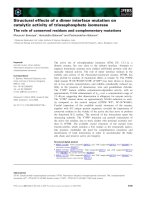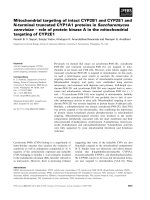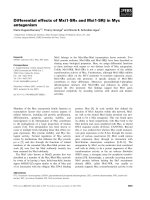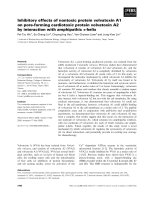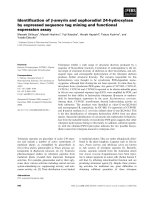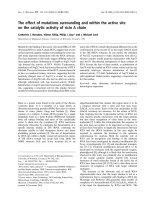Báo cáo khoa học: "ASIMPLIFIED THEORY OF TENSE REPRESENTATIONS AND CONSTRAINTS ON THEIR COMPOSITION" potx
Bạn đang xem bản rút gọn của tài liệu. Xem và tải ngay bản đầy đủ của tài liệu tại đây (453.41 KB, 8 trang )
A SIMPLIFIED THEORY OF TENSE REPRESENTATIONS
AND CONSTRAINTS ON THEIR COMPOSITION
Michael R.
Brent
MIT
Artificial Intelligence Lab
545 Technology Square
Cambridge, MA 02139
ABSTRACT
This paper proposes a set of representations for
tenses and a set of constraints on how they can be com-
bined in adjunct clauses. The semantics we propose ex-
plains the possible meanings of tenses in a variety of sen-
tential contexts. It also supports an elegant constraint
on tense combination in adjunct clauses. These semantic
representations provide insights into the interpretations
of tenses, and the constraints provide a source of syntac-
tic disambiguation that has not previously been demon-
strated. We demonstrate an implemented disambiguator
for a certain class of three-clause sentences based on our
theory.
1 Introduction
This paper proposes a set of representations for tenses
and a set of constraints on how they can be combined.
These representations provide insights into the interpre-
tation of tenses, and the constraints provide a source of
syntactic disambiguation that has not previously been
demonstrated.
The sentences investigated in this paper contain
multiple clauses connected by temporal/causal con-
nectives, words like once, by the time, when, and be-
fore. (1) shows that the tenses of multi-clause sentences
affect their acceptability. This raises several important
*when }
(1) a. * Rachel won the game *once Jon
*before
arrives
here answer these questions. Specifically, they provide
explanations in terms of the meanings of the tenses. We
propose an explanatory theory and demonstrate an im-
plementation which successfully disambiguates a class of
three-clause sentences.
The issues raised by (1) are significant for compu-
tational linguistics on several accounts. First, an under-
standing of the constraints on tense combinations can be
used to support syntactic disambiguation. For example,
consider the alternative parses shown textually in (2)
and graphically in Figure -1. The first parse in both
(2) a. oK
b. *
[s Jon will learn [s that he won s/ when
Rachel arrivess]
Read as: When Rachel arrives, Jon will
learn that he won
Jon will learn [s that he won when Rachel
arrives s/
Read as: Jon will learn that, when
Rachel arrives, he won
(2) and Figure -1, where the adjunct clause starting with
when is attached high, is fine; the second, where it is at-
tached low, is unacceptable. Figure -1 demonstrates our
parser discriminating between the acceptable and unac-
ceptable parses of (2). The details of the representation
cannot be understood until later, but it can be seen that
different compositions of the tenses in the two parses
result in marking the top node of the second parse as
bad. The contrast between example (2) and example (3)
shows that whether the preferred attachment depends on
the tenses of the clauses. Examples (2) and (3) show
b. OK Rachel will win the game
Jon arrives
when }
once
before
questions. Which tense combinations are acceptable and
which are not? Why do they have the status they do?
How can observations like (1) be used to leverage prob-
lems like syntactic disambiguation and knowledge repre-
sentation? The representations and constraints proposed
(3) a. *
b. OK
that there are
[s Jon will learn [s that he had won s/by
the time Rachel arrived s/
Read as: By the time Rachel arrived,
Jon will learn that he had won
Jon will learn [s that he had won by the
time Rachel arrived s/
Read as: Jon will learn that by lhe lime
Rachel arrived he had won
interesting interactions among tenses, and
119
(print-trees
(porse-ond-ceeput e-tense-structures
'(Jon ulll learn that
he ted
ale uhen Rachel *s arrive)))
I~S: E.R R_S POST
,
I
S_R I. E FUT
I I I E(e)fE(e)
S, R R, E
PRES
[T v
FUT TEUPORRL-CONN
P~ uP: S_R U,E
T.: [ "ffi'=ll=': u., ,., ,,E,I
'
E. l l S PUUTJ
°ou,.ER I s. "STI I::: ,.R ,.E ''ESI
ITS: S R
R,E FUT
TS: E,R l_S
JTZRE:-FUTURE
~ERF: -
ITZflEZTURE, ~'~'=" ~ iSS: T' 'U'LEU-VERll I
E.R R_S
ITS: $,R
R.E PRES
SP.'~E.R R ITZHE: ,RESENT
~ERF:
-
• JTEIfSE-U~
P _S POST
lk'] i'~ iTTnE: PUESENTi ~
~o.,~ER-~, I
T I Ts:
E.u R S PnUTI
I ITXUE: ,OUT - I
± r-i~ I
g
£.R R_S POST
i
J IO I
s
violates: UCTR ]
R.E OuR PRES~
S_R R.~ FUT
E.R I S POST
I
I-I
s vlelotes: UCTR
R.E S.R PRE:
U_I R.E
FU1
i: FUTURE
FUIURE
I T8= E.R R S POUT J
I I I'I I
I $ violates= OCTR I
t
O,E S,n ,REU~
~Ss E.l l U PUST
I
I I I'1
I
I I "
violates:
SCIR
I
I i u. 1 S.R,R,~
~ I::: E.u i.s 'R-I i~;'~-':::~:* o,, I"" u., u.E ,RESI
I.o ~Eu-uE' , W~ '~
,.u= u R U T, I*% PUEUl
|
ITEnE:
PUUT - I $,l R.E
_L ~ERF:- I
TENSE-U~
I
~rT'
D~,r~mic Lisp Listener I
.I
Figure -1: The output of our parser on the sentence in (2). The restrictions on tense combination disambiguate this sentence,
shown by the asterisk with which our program marks the second parse as unacceptable. Note that the restrictions on the
complement clauses are different from those on a~ijunct clauses. The former are not discussed in this paper, but see Hornstein
(1990).
120
that a good theory of these interactions would be use-
ful for syntactic disambiguation. Such a theory, and an
implementation of a disambiguator based on it, are the
subjects of this paper.
In addition to its potential for syntactic disam-
biguation, a theory of these temporal adjunction phe-
nomena is may guide the construction of model-theoretic
interpretations of the temporal and causal relations
among events. Finally, people clearly have a lot of knowl-
edge about the interaction among tenses. By making this
knowledge explicit, we are likely to open new, unfore-
seen avenues to improving the performance of natural
language processing devices.
1.1 Context
The subjects of tense and temporal representation
have generated a great deal of interest in artificial intel-
ligence, computational linguistics, linguistics, and phi-
losophy. Work in these areas addresses a variety of in-
teresting questions which can be broadly divided into
two types: questions about representing the temporal
knowledge conveyed by natural language, and questions
about representing role of tense in sentential grammar.
The former questions have often been addressed by at-
tempting to construct a model-theoretic semantics of cer-
tain temporally significant linguistic constructions. Im-
portant work in this area includes Dowty (1979), Allen
(1984), Dowty (1986), Hinrichs (1986), Moens (1987),
and Hinrichs (1988). Much of the recent work in this
area has used some version of Reichenbach's (1947) rep-
resentation of tenses as a starting point) The questions
about the role of tense in sentential grammar, and in
particular about its effect on the acceptability of various
sentence types, has been addressed by a different set of
researchers. This work, which also uses Reichenbach as
a starting point, is well represented by Hornstein (1990)
and Comrie (1985), and the works cited therein. In this
paper, we focus on how tenses affect the acceptability of
sentences, but we attempt to explain their effect in terms
of their interpretations. While we explain certain obser-
vations about the acceptability of sentences in terms of
interpretations, we do not attempt to develop a theory
of the temporal interpretation of natural language. 2
Earlier attempts to explain the phenomena under
study here include Hornstein (1977), Hornstein (1981),
Yip (1986), and Hornstein (1990). In the current pa-
per, we attempt to remove some semantic underdeter-
mination and some theoretical redundancy that we have
1Hinrichs, 1986; Harper and Gharniak, 1987; Hinrichs,
1988; Moens and Steedman, 1988; Nakhimovsky, 1988; Pas-
soneau, 1988; and Webber, 1988
2In particular, the important issue of tense as discourse
anaphor is not addressed. (See Hinrichs, 1986; Moens, 1987;
Hinrichs, 1988; Nakhimovsky, 1988; and Webber, 1988.) Fur-
ther, we do not have a theory of the interaction of temporal
interpretation with aspect. (See Dowty, 1979; Dowty, 1986;
Moens, 1987; Moens and Steedman, 1988; Nakhimovsky,
1988; and Passoneau, 1988.)
found in these works. Section 5 provides a more de-
tailed comparison with Yip (1986) and Hornstein (1990).
Along with Hornstein and Yip, Harper and Charniak
(1987) also propose a set of rules to account for the ac-
ceptability of tense combinations in adjunct construc-
tions. However, their primary interest is in representing
the temporal knowledge that can be conveyed by natu-
ral language. As a result, they explicitly choose not to
use their semantic system to construct an explanation
for their adjunction rules; rather they propose their ad-
junction rules as syntactic descriptions. By contrast, the
current paper focuses primarily on developing a semantic
explanation of tense compatibility.
Although we do not offer specific variations on the
model-theoretic approach, we hope that our work will
further it indirectly. At a minimum, since many model
theoretic approaches use Reichenbach's (1947) tense rep-
resentations, our insights into those representations may
be significant. Further, we hope that our constrained
rules for composing those individual tense structures will
provide a richer set of representations on which model
theoretic approaches can be built.
1.2 Preview
The remainder of this paper proceeds as follows.
Section 2 introduces the representations for individual
tenses. Section 3 presents the method of composing
tenses from different clauses, and a general constraints
that applies to such composition. 3 Section 4 demon-
strates the computer program implementing this theory.
Section 5 steps back from the technical details to assess
the contributions of this paper and compare it to closely
related works. Finally, Section 6 sums up the conclusions
drawn throughout the paper. 4
2 The Representation of Individual
Tenses
In order to construct a theory explaining which
tenses can be combined we need a representation of the
tenses. The representation used here is variant of that
used by Hornstein (1990), who bases it on Comrie (1985).
It is a Neo-Reichenbachian representation (Reichenbach,
1966) in that its simple tense structures (STSs) re-
late the following three entities: the time of the event
named by the verb, denoted by "E", the time of speech,
denoted by "S", and a reference time, denoted by "R".
The reference time R is used to locate an event with re-
spect to another event in sentences like (lb) above. (A
mechanism for connecting tenses via the 1% point will be
3Brent (1989) presents two additional constraints on tense
composition.
4While English alone has been studied in detail, prelimi-
nary investigation supports the expectation that the theory
will extend to Romance and Germanic languages. One of
the most obvious difference between Romance and Germanic
languages is addressed in Brent (1989).
121
X_Y Y_X X,Y Y,X
Table 1: Notation for possible relations between
time points X and Y
Tense Name Simple Tense Example VP
Structure
past
present
future
past perfect
present perfect
future perfect
E,R R_S
S,R R,E
S-R R,E
E_R R-S
E_R S,R
E_R S_R
Jon WOn
Jon wins,
is winning
Jon will win
Jon had won
Jon has won
Jon will have won
Table 2: The six STSs expressible in English ver-
bal morphology
detailed in Section 3.) Each STS consists of a relation
between S mad R and one between R and E; S and E are
not directly related. For any directly related time points
X and Y, at most one of four possible relations holds be-
tween them. These are written as in Table 1. Although
we use the same notation as Hornstein (1990), we view it
as merely notation for fundamentally semantic relations,
whereas he appears to view the syntax as primary.
For the purposes of constraining tense combination
there appear to be six basic tenses 5 (Table 2). We assign
STS representations to tenses as shown in Table 2. One
of the main contributions of this paper over previous
attempts will be its ability to completely determine the
assignments of Table 2 in terms of the semantics of the
representations and the meanings of actual tenses.
The assignment of STSs to tenses shown in Table 2
can be derived from the possible interpretations of vari-
ous tenses. Before arguing that Table 2 can be derived,
we note that it is at least consistent with the interpre-
tations of the tenses. Suppose that underscore is inter-
preted as temporal precedence and comma as simultane-
ity (As in Hornstein, 1990. Under this interpretation the
various tense structures correspond to the evident mean-
ings of the tenses. For example, the STS of the past tense
is "E,R R.S." That is, the event referred to by the clause
is simultaneous'with some reference point R, which pre-
cedes the time of speech (E = R < S). It follows that
the event precedes the time of speech, which corresponds
to the evident meaning of the past tense. On the other
hand, the proposed semantics for comma and underscore
cannot completely determine the assignments shown in
Table 2, because Table 2 distinguishes X,Y and Y,X,
5The constraints on tense combination appear to be en-
tirely independent of whether or not the tensed verb bears
progressive morphology.
but the semantics does not assign them distinct mean-
ings. That situation is remedied by introducing a new
and slightly more complex interpretation for comma, as
described in (4).
(4) Interpretation of "X,Y':
a. Y does not precede X.
b. X is simultaneous with Y, in the absence of
evidence that X precedes Y. (Such evidence
can come from other tenses, adverbs, or con-
nectives, as described below.)
c. X precedes Y, in the presence of supporting
evidence from other tenses, adverbs, or con-
nectives.
The reinterpretation of comma as precedence due to the
presence of an adverb is illustrated in (5). Although
(5) i{ leave } { OK tomorrow }
am leaving for LA * yesterday
leave is in the present tense, it is interpreted as a future
because of the adverb tomorrow. The fact that adjec-
tives can cause the present tense to be reinterpreted as
a future but not as a past indicates that its STS must
be S,R R,E, not any of the permutations like S,R E,R.
If the present had S,R E,R as its STS then E,R could
be reinterpreted such that E < R = S, a past. Similar
arguments can be made for the other STSs in Table 2.
Further, evidence that both tenses from other clauses
and temporal/causal connectives can cause comma to
be reinterpreted as precedence will be presented below.
Note that (4) does not mean that "X,Y" is inter-
preted as "X is prior to or simultaneous with Y". Rather,
a particular occurrence of "X,Y" Mways has exactly one
of the following two interpretations: 1) X is simultane-
ous with Y; 2) X is prior to Y. "X,Y" is never ambiguous
between the two. 6
3 Causal/Temporal Adjunct Clauses
In this section we introduce a composition opera-
tion on STSs, and a major constraint on composition.
It is important to keep in mind that we are discussing
only causal/temporal adjunct clauses. In particular, we
are not considering complement clauses, as in "Rachel
knows that Jon played the fool yesterday."
3.1 Tense Composition and Semantic
Consistency
When one clause is adjoined to another by a tem-
poral/causal connective like once, by the lime, when, or
before the acceptability of the resulting sentence depends
in part on the tenses of the two clauses. This is demon-
strated by (1). In fact, of the 36 possible ordered pairs
~This is different from Yip (1986), where comma is cru-
cially interpreted as ambiguous between the two readings.
122
of tenses only nine are acceptable when put in adjunct
constructions like (1). (The nine acceptable tense pairs
are listed in Table 3.) 20 of the 27 unacceptable ones,
but none of the nine acceptable ones, have the following
character: their adjunct-clause SR relation is inconsis-
tent with their matrix-clause SR relation, and cannot
be reinterpreted according to (4) in a way that makes it
consistent. This can be understood in terms of the merg-
ing of the adjunct Sit relation with that of the matrix,
yielding a combined
tense structure
(CTS) that has
only the matrix SR relation. Besides explaining the ac-
ceptability status of many CTSs, the idea of merging the
adjunct SR relation into that of the matrix makes sense
in terms of the representational schema. In particular,
the idea that the adjunct's R point should be identified
with that of the matrix through causal/temporal adjunc-
tion is consistent with the representational schema which
uses R as a reference point for relating one event to an-
other. Furthermore, since "S" is a deictic point repre-
senting the time of speech (more accurately, the time
of proposition), and since both clauses represent propo-
sitions made in the same context, it makes sense that
they should have the same S point. Once the S and R
points of the adjunct clause have been identified with
that of the matrix clause, it makes sense that sentences
where the matrix asserts one order for the shared S and
R points while the adjunct asserts another order would
be irregular.
Before attempting to formalize these intuitively ap-
pealing ideas, let us consider an example. The notation
for CTSs is as follows: the STS of the matrix clause is
written above that of the adjunct clause and, if possible,
the identified S and R points are aligned and connected
by vertical bars, as shown in (6). 7
(6) S_R R,E FVrURE (WIN)
i f l
S,R R,E PRESENT (ARRIVE)
(6) is the CTS for sentence (lb). Although the SR re-
lation for the present tense adjunct is not identical to
that of the future tense matrix clause, the adjunct can
be reconciled with that of the matrix clause if the S,R is
interpreted as precedence, S < R. Notice that sentence
(lb) is, in fact, interpreted such that the arriving oc-
curs in the future, even though the verb is in the present
tense. Because of the two possible interpretations of the
comma relation proposed in (4), a single representation
accounts for the possibility of interpreting the present as
a future. Further, by making the (still informal) restric-
tion on tense composition a semantic one, we use the
same mechanism to account for tense compatibility.
Now consider an unacceptable example. (la) has
7all tense structures shown in typewriter face are actual
output from our program. When they are reported as the
tense structure for
a particular sentence, then the program
generated them in
response to that
sentence. For more on
the implementation, see Section 4.
the CTS shown in (7). Note how the matrix clause as-
(7) E,R R_S PAST (WIN)
[ it
*
violates: ACIR
R,E S,R PRESENT (ARRIVE)
serts that the (shared) R point precedes the (shared) S
point, while the adjunct clause asserts that the R point
is simultaneous with the S point. The adjunct clause
could be reinterpreted according to (4) such that the R
point follows the S point, but this would not help the
assertions on the two levels would still be inconsistent.
In general, if the SR relation on the matrix and adjunct
tiers of the CTS do not have the same left-to-right order
then their meanings cannot be reconciled, s
We have proposed that the adjunct SR relation
must be consistent with the matrix SR relation, argued
that this constraint is intuitively appealing and conso-
nant with the representational system as a whole, and
shown an example. Despite the intuitive appeal, there
are two hypotheses here that should be made explicit:
first, that the SR relation of the adjunct clause is merged
with that of the matrix when temporal/causal adjuncts
are interpreted; and second, that CTSs containing con-
tradictory assertions as a result of that merger are ex-
perienced as unacceptable, not merely implausible. We
codify those two hypotheses as follows:
Adjunct Clause Information Restriction (ACIR):
"Adjunct clauses that introduce new SR information into
the CTS are unacceptable."
3.2 Interpretation of CTSs
The interpretation of comma offered in (4), in combi-
nation with the ACIR, explained the incompatibility of
20 tense combinations in causal/temporal adjunct con-
structions. Thus the new interpretation has important
consequences for the SR portion of the CTS, the por-
tion referred to by the ACIR. We now explore its conse-
quences for the RE portion of the CTS.
According to the ACIR a CTS contains only a sin-
gle SR relation, that provided by the matrix clause.
Since both the matrix event (E, nat) and the adjunct
event
(Ea4i)
bear temporal relations to their shared R
point, it follows that they may be comparable. For
example, the structure shown in (8b) is interpreted as
Emat < R = Earl1,
by default. (Our program prints
out the default
Emat - Eadj
comparison for valid CTSs,
but they have been suppressed up to now. In addition,
Table 3 lists all tense combinations that yield acceptable
CTSs according to the
Emat - Earl1
ordering of their
SThis is shown in greater detail in Brent (1989). Also, note
that Hornstein (1990) takes this condition on the form of the
CTSs as primary instead of reducing it to their meanings.
For discussion of the differences, see Section 5.
123
(8)
a.
b.
Jon had won the game when Rachel arrived
(
E_R R_S PAST-PERFECT
[ [ J
E(m)<E(a)
E,R R_S PAST)
inatrix
adjunct
matrix
adjunct
matrix
adjunct
E,~,~ < Ea@
past perf.
past
present perf.
present
future perf.
present
Ead i
<
Emat
past
past perf.
present
present perf.
future
present perf.
Ea~j = E,~
past
past
present
present
future
present
Table 3: Legal tense combinations, arranged by
apparent
E~dj - Emat
deduction
default interpretation.) Sentence (8a) does indeed im-
ply that the matrix event (Jon's winning) occurred be-
fore the adjunct event (Rachel's arriving). If the comma
in "E,~,t,R" could be reinterpreted as temporal prece-
dence then, instead of
Emat < R = Eadj,
we would have
Emat < R and
E~dj < R; Era,,
and
E~dj
would be in-
comparable. Brent (1989) proposed a constraint ruling
out CTSs that do not yield an
Em,t - Eadj
comparison.
The reason for that proposal was the unacceptability 9 of
sentences like (9). Now consider the following reformu-
(9) a.
b.
$on had won the game when Rachel had ar-
rived
(
E_R R_S PAST-PERFECT
I I I
* violates: interpretation
E_R R_S PAST-PERFECT)
lation of that constraint:
Interpretation Constraint: "An acceptable interpre-
tation of a CTS must yield an E,,a, - Eadj comparison."
This reformulation allows the same constraint both to
narrow the possible interpretations of constructions like
(8) and to explain the problematic status of construc-
tions like (9). Reexamining (8),
Ea~, R
cannot be rein-
terpreted because to do so would violate the Interpreta-
tion Constraint;
Emat-R
cannot be reinterpreted because
underscore has only the precedence interpretation. Thus
(8) has only a single interpretation.
Now consider CTSs with E,~a,, R and E~dj, R, and
in (10c). Their default interpretation will be
E, nat=
R = Eaaj.
But by picking appropriate temporal/causal
9For present purposes it does not matter whether sen-
tences like (9) are regarded as strictly ungrammatical or
merely reliably infelicitous.
connectives or pragmatic contexts we can force either
comma to be reinterpreted, yielding
Eadj < R = E,,~, as
in (10a), E,~t < R =
Eadj as
in (10b)) ° Of course, the
(10)
a. OK
Jon quit his job after Rachel left him
b. OK Rachel left Jon before he quit his job
c. (
E, R R_S PAST
[
[ [
E(m)=E(a)
E,R R_S PAST)
Interpretation Constraint prevents both commas from
being simultaneously reinterpreted.
We have shown that the interpretation of comma
offered in (4) provides a flexibility in the interpretation
of CTSs that is required data such as (10). Further,
it restricts the interpretation of constructions like (8),
where one of the clauses is in a perfect tense. Although
we cannot fully explore the interpretive range of such
perfect constructions here, the restriction on them has
intuitive appeal.
4 The Computer Model
This section describes our implementation of the theory
described above. The implementation serves two pur-
poses. First, we use it as a tool to verify the behavior
of the theory and explore the effects of variations in it.
Second, the implementation demonstrates the use of our
tense theory in syntactic disambiguation.
Our program operates on parse trees, building com-
plex tense structures out of simple ones and determining
whether or not those CTSs are acceptable, according to
the constraints on tense combination. This program was
linked to a simple feature-grammar parser, allowing it
to take sentences as input, n In addition to building
the CTS for a sentence, the program lists the apparent
Emat - Ea4/ relation for the CTSs it accepts, and the
constraints violated by the CTSs it rejects. Its behav-
ior on several of the examples from Section 1 is shown
below.
Examples (la) and (lb) show the effects of the Ad-
junct Clause Information Restriction on the acceptabil-
ity of sentences.
;;;
(la) * Rachel won the game when
Jon arrives
(compute-tense-structures
(parse
'(Rachel +ed win the game when Jon +s arrive)))
1°See also Moens and Stccdman, 1988 regarding
when
clauses.
11 Because morphology is quite distant from our interest in
tense, the parser has no morphological component. Instead,
input sentences have their tense morphemes, such as
+ed,
separated and preposed. A morphological parser could easily
return the components in this order.
-t-ed
represents the past-
tense morpheme, +s the present-tense morpheme, and
4-en
the past participle morpheme.
124
(
E,R R_S PAST (WIN)
I 11
*
violates: ACIR
R,E S,R PRESENT (ARRIVE))
;;; (lb) ok Rachel sill
sin the game ehen
Jon arrives
(compute-tense-structures
(parse
'(Rachel sill win the game shen Jon +s arrive)))
(
S_R R,E FUTURE (WIN)
J I I E(m)-E(a)
S,R R,E PRESENT (ARRIVE))
Examples (2) and (3) show how a sentence with two
possible adjunction sites for the adjunct clause can pro-
duce two CTSs. The unacceptability of the CTSs re-
sulting from one of the adjunction sites disambiguates
the sentences. In sentence (2) it is high attachment, to
the matrix clause, that is acceptable; in sentence (3),
low attachment to the complement clause. Figure -1,
page 2, shows the two possible parses of (2) output by
our program. One of them is automatically labeled un-
grammatical with an asterisk on its CTS. Note that the
composition of tenses from subcategorized complement
clauses, as opposed to adjunct clauses are not investi-
gated here, but rather adopted from Hornstein (1990).
5 Discussion
In this section we compare the preceding solutions to the
temporal/causal adjunction problem with those offered
in Yip (1986) and Hornstein (1990).
5.1 Semantics of Simple Tense Structures
Two other works, Yip (1986) and Hornstein (1990),
have developed theories of the effect of tense on the
acceptability of temporal/causal adjunct constructions.
Both of these are at least partially rooted in the mean-
ings of the tenses, and both use representations for sim-
ple tense structures that are similar to the ones used
here. However, they both have difficulty in justifying
the assignment of STSs to tenses.
Yip assumes that comma is ambiguous between <
and =. Notice that this is different from the default
interpretation suggested here, whereby a given comma
in a given tense structure has exactly one interpreta-
tion at any one time. Yip's assumptions are critical for
the explanatory power of his argument, which won't go
through using a default interpretation. According to
Yip's interpretation, "Jon is running" and "Jon runs"
ought to be ambiguous between the present and the fu-
ture, but they clearly are not. Both describe events or
sets of events that necessarily must include the time of
speech. This problem is exacerbated by Yip's proposal
that the present tense be assigned two STSs, one equiva-
lent to "S,R R,E", the one used here, and the other "E,R
R,S". This proposal, along with the ambiguous interpre-
tation of comma, would predict that the present tense
could be interpreted as meaning the same thing as nearly
any other tense. For example, the present could be inter-
preted as equivalent to the past perfect, if both commas
in its "E,R R,S" STS received the reading E < R < S.
Hornstein (1990) uses the simultaneity interpreta-
tion of comma exclusively in assigning STSs to tenses.
Thus there is no semantic reason, in Hornstein's model,
why the present tense should have "S,R R,E" rather than
"S,R E,R". Furthermore, reinterpretation of comma is
not invoked to explain the fact that the present tense
is reinterpreted as referring to the future when it is ad-
joined to a future clause or modified by a future adverb.
Instead, a syntactic rewrite rule that changes X,Y to
X_Y under these conditions is used. However, in the
absence of semantic constraint, it is not clear why that
rule is better than one that switches order too, rewrit-
ing Y,X to X.Y. This alternative rewrite rule would be
consistent with the observations if every X,Y in every
STS were switched to Y,X. Since X,Y and Y,X are in-
terpreted in the same way in Hornstein's theory, there
is no reason not to make these two changes. That is to
say, Hornstein's theory does not explain why the STSs
and the rewrite rule are the way they are, rather than
some other way.
Yip could not correctly derive his STS/tense map-
ping from the meanings of the tenses because he allowed
each STS to have too many different meanings in the
simple, unmodified situations. Even so, these meanings
were too narrow for his constraint on adjunction, so he
was forced to propose that the present has two STSs.
This only made the underdetermination of the mean-
ings of simple sentences worse. Hornstein, on the other
hand, did not allow enough variation in the meanings
of the simple tense structures. As a result, many of his
possible STSs had equivalent meanings, and there was
no way to prefer one over the other. This was exacer-
bated by the fact that he used non-semantic constraints
on adjunction, reducing the amount of constraint that
the acceptability data on adjunctions could provide for
the assignment of STSs to tenses. This paper takes an
intermediate position. Comma is interpreted as simul-
taneity in the unmodified case, but can be interpreted as
precedence in appropriate environments. Since the con-
straints on adjunction are semantically based, the inter-
pretations of adjunct constructions provide evidence for
the assignments of STSs to tenses that we use.
5.2 Semantics of Combined Tense Structures
In addition to allowing semantics to uniquely de-
termine the assignment of STSs to tenses, our default-
based interpretation of comma explains a problem ac-
knowledged in Hornstein (1990). If comma is inter-
preted as strict simultaneity, as Hornstein initially pro-
poses, then the structure in (10c) must be interpreted
as Emat = R = Eadj.
However, as noted above, neither
sentence (10a) nor sentence (lOb) has this interpretation.
Hornstein alludes to a different form of reinterpretation
125
of ER to account for examples like (10). However, his
mechanism for the interpretation of Ernat - Eadj order-
ing in CTSs is unrelated to his semantics for STSs or his
constraints on their combination. Our explanation, by
contrast, uses the same mechanism, the default-based se-
mantics of comma, in every portion of the theory. Rein-
terpretation of comma in the SR relation accounts for the
compatibility of the present tense with future adverbs
and future matrix clauses. Reinterpretation of comma
in ER relations accounts for the flexible interpretation
of sentences like those in (10).
6
Conclusions
This paper describes two contributions to the the-
ory of temporal/causal adjunction beyond those of Yip
(1986), Brent (1989), and Hornstein (1990). First, we
propose the asymmetric, default-based interpretation of
comma described in (4). This leads to a uniform, seman-
tically based theory explaining the assignments of STSs
to tenses shown in Table 2, the incompatibility of many
tense pairs in causal/temporal adjunction, and the in-
terpretations of combined tense structures in a variety
of situations. In particular, the default based interpre-
tation of comma has benefits both in the interpretation
of SR relations (adverbs and clausal adjuncts) and ER
relations (event order in CTSs). Few of the theoretical
observations or hypotheses presented in this paper con-
stitute radical departures from previous assaults on the
same problem. Rather, this paper has worked out incon-
sistencies and redundancies in earlier attempts. Besides
theoretical work, we presented a computer implementa-
tion and showed that it can be used to do structural
disambiguation of a certain class of sentences. Although
our contribution to syntactic disambiguation only solves
a small part of that huge problem, we expect that a
series of constrained syntactic/semantic theories of the
kind proposed hear will yield significant progress.
Finally, the adjustments we have suggested to the
interpretation of comma in both simple tense structures
and combined tense structures should contribute to the
work of the many researchers using Reichenbachian rep-
resentations. In particular, constrained combination of
tense structures ought to provide a richer set of represen-
tations on which to expand model-theoretic approaches
to interpretation.
Acknowledgments
Thanks to Bob Berwick and Norbert Hornstein for their
detailed readings and invaluable comments on many ver-
sions of this work.
References
[Allen, 1984] J. Allen. Towards a General Theory of Ac-
tion and Time. AI Journal, 23(2), 1984.
[Brent, 1989] M. Brent. Temporal/Causal Connectives:
Syntax and Lexicon. In Proceedings of the 11th Annual
Conference of the Cognitive Science Society. Cognitive
Science Society, 1989.
[Comrie, 1985] B. Comrie. Tense. Cambridge Textbooks
in Linguistics. Cambridge U. Press, New York, NY,
1985.
[Dowty, 1979] D. Dowty. Word Meaning and Montague
Grammar. Synthese Language Library. D. Reidel,
Boston, 1979.
[Dowty, 1986] D. Dowty. The effects of aspectual class
on the temporal structure of discourse: Semantics or
pragmatics? Linguistics and Philosophy, 9:37-61,
1986.
[Harper and Charniak, 1987] M. Harper and E. Char-
niak. Time and tense in english. In ??th Annual
Proceedings of the Association for Comp. Ling., pages
3-9. Association for Comp. Ling., 1987.
[tIinrichs, 1986] E. Hinrichs. Temporal anaphora in dis-
courses of english. Linguistics and Philosophy, 9:63-
82, 1986.
[Hinrichs, 1988] E. Hinrichs. Tense, quantifiers, and con-
text. Comp. Ling., 9(2), 1988.
[Hornstein, 1977] N. Hornstein. Towards a theory of
tense. Linguistic Inquiry, 8:521-557, 1977.
[Hornstein, 1981] N. Hornstein. The Study of Meanin 9
in Natural Language. Longman, New York, 1981.
[I-Iornstein, 1990] N. Hornstein. As Time Goes By:
Tense and Universal Grammar. MIT Press, Cam-
bridge, MA, 1990.
[Moens and Steedman, 1988] M. Moens and M. Steed-
man. Temporal Ontology and Temporal Reference.
Comp. Ling., 14(2), 1988.
[Moens, 1987] M. Moens. Tense, Aspect, and Tempo-
ral Reference. PhD thesis, University of Edinburgh,
Centre for Cognitive Science, 1987.
[Nakhimovsky, 1988] A. Nakhimovsky. Aspect, aspec-
tual class, and the temporal structure of narrative.
Comp. Ling., 14(2), 1988.
[Passoneau, 1988] R. Passoneau. A computational
model of the semantics of tense and aspect. Comp.
Ling., 14(2), 1988.
[Reichenbach, 1966] H. Reichenbach. The Elements of
Symbolic Logic. The Free Press, New York, 1966.
[Webber, 1988] B. Webber. Tense as a discourse
anaphor. Comp. Ling., 14(2), 1988.
[Yip, 1986] K. Yip. Tense, aspect, and the cognitive rep-
resentation of time. In Proceedings of the A CL. Asso-
ciation for Comp. Ling., 1986.
126
